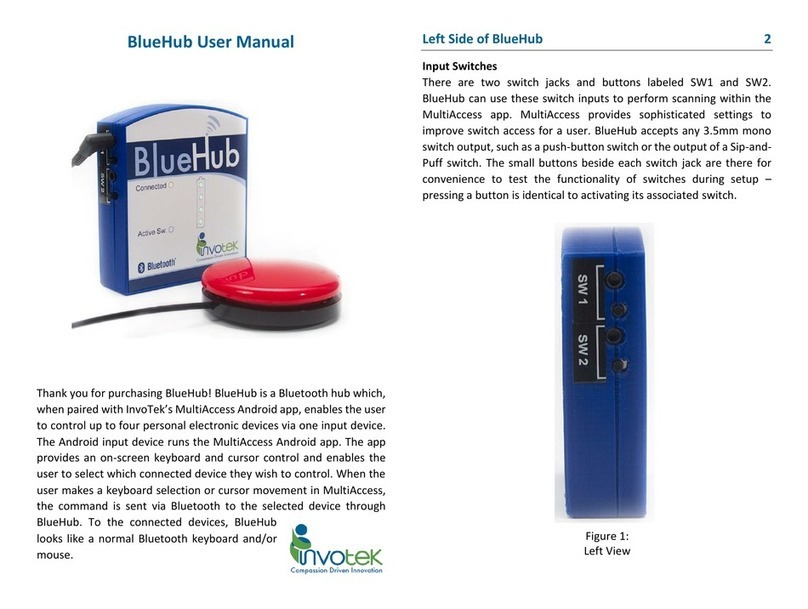Switch Configurations 7
This section describes how to setup the DIP switches for common
BlueSwitch users. If you need additional customization, you can
download our free BlueSwitch Android app found on Google Play.
Please contact us if you need assistance configuring BlueSwitch.
Three Switch User
If the user can activate three switches, connect each switch to inputs
SW1, SW2, and SW3. This will allow the user to output two Bluetooth
switch activations with SW1 and SW2 and cycle through connected
Bluetooth devices with SW3. A common use for this configuration
would be 2-switch step scanning or 2-switch operating system control,
with an additional dedicated switch for cycling through connected
devices.
For this mode, ensure DIP Switch 1 is ‘off’. The functionality of SW1
and SW2 is dependent upon DIP Switches 2 - 4, as described in the “DIP
Switch Settings” above.
Two Switch User: Both Switches Used for Switch Activation Outputs
This configuration outputs a Bluetooth switch activation on each
switch (SW1 and SW2) and also cycles through connected devices by a
long press on SW1. The two switches should be connected to SW1 and
SW2. A common use for this would be for 2-switch step scanning or 2-
switch operating system control, while cycling through connected
devices by a long SW1 switch press.
For this mode, ensure DIP Switch 1 is ‘on’. A short press (less than 1.5
seconds and before BlueSwitch beeps) on SW1 will output a Bluetooth
switch activation on release and SW2 will output a Bluetooth switch
activation on press. To cycle between connected devices, perform a
long press on SW1 by holding down the switch for 3 seconds until the
Active Sw. LED turns orange and there is a double beep sound.
Switch Configurations 8
Two Switch User: One Switch for a Single Switch Activation Output,
One Switch for Cycling Between Devices
This configuration enables one switch for a single Bluetooth output and
one switch dedicated to cycling among devices. The switch used for
Bluetooth output should be connected to SW1 and the switch used to
cycle between connected devices should be connected to SW3.
For this mode, ensure DIP Switch 1 is ‘off’. SW1 functionality is
dependent upon DIP Switch 2 and 3, as detailed in the “DIP Switch
Settings” above.
Single Switch User
If the user operates a single switch, their switch should be connected
to SW1. With this configuration SW1 can be used to output a single
switch activation to connected Bluetooth devices, output two different
switch activations to connected Bluetooth devices differentiated by a
short or long press, or cycle among connected devices using an
extended long press.
For this mode, ensure DIP Switch 1 is ‘on’. Switch activations are output
upon release of the switch. The first Bluetooth output occurs with a
short press on the switch (less than 1.5 seconds and before BlueSwitch
beeps). To perform the second Bluetooth output, perform a long press
on the switch until the Active Sw. LED is red (greater than 1.5 seconds
but less than 3 seconds or said another way, after BlueSwitch beeps
once but before it beeps twice). To cycle between connected devices,
perform an extended long press on the switch until the LED turns
orange (holding down the switch for 3 seconds or until it double
beeps).
























